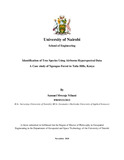| dc.description.abstract | The impacts of climate change in the African continent have far reaching effects because it is a region of high vulnerability to climate shocks; it threatens food security, livelihoods and biodiversity. African forest ecosystems, which are interlinked to food production systems, are among the most impacted by world climate change. More so, the indigenous tree species are at a high risk of extinction hence the need to quantify them for conservation purposes. Modern methods such as remote sensing and specifically hyperspectral remote sensing offer more accurate methods with expansive scope for conservation, compared to the tedious and time-consuming methods that were previously used. Generally, this study aimed at mapping the indigenous and exotic tree species appearing on the top canopy in Ngangao forest using airborne hyperspectral data. Specifically, it aimed at determining the appropriate wavelengths for mapping of selected tree species; mapping selected tree species using different classification algorithms and the selected appropriate spectral bands; and testing the potential application of simulated multispectral data to discriminate tree species in Ngangao Forest. The Ngangao Forest is located in the Taita Hills in Kenya, approximately 100 km east of Kilimanjaro. The hyperspectral image was acquired using AISA Eagle VNIR sensor and used to map the tree species in Ngangao Forest using different algorithms. Simulated multispectral images with different spatial resolutions were used to map the same tree species and their accuracies compared with those of the hyperspectral images. Classification accuracies of between 49% and 80% were achieved using different machine learning algorithms. Spectral Angle Mapper proved to be the most inferior with an overall accuracy of 49.24% while Random Forest was the most superior with an overall accuracy of 80.00%. Among the species, Pinus patula and Albizia gummifera were the most accurately mapped while Macaranga capensis and Phoenix reclinata were the least accurately mapped. The Random Forest ensemble eliminated redundant bands to achieve an optimal 53-band image for classification. These bands were centred around the blue, green, red-edge and infra-red regions of the electromagnetic spectrum. Simulating multispectral images to Worldview 2 and Sentinel 2, reduced the disk size and processing load on the computer. However, the species identification accuracy reduced while the training and testing sites were considerably fewer as the spatial and spectral resolution reduced. Ultimately, an increment in spectral and spatial resolution increases the species classification accuracy of the tree species in Ngangao Forest. An algorithm with the ability to use fewer training sites and an image resolution that enables one to collect more accurate
end members would achieve higher species classification accuracies using multispectral images. In the absence of this, hyperspectral images provide an alternative to this lacuna | en_US |



